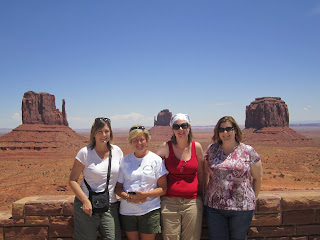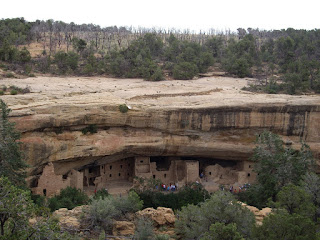Remarkable Ruin
Sand Canyon Pueblo is an archaeological ruin located at the Northern trailhead of Sand Canyon. It is part of the Canyons of the Ancients, a national park authorized under the Bill Clinton administration. This was my FAVORITE ancient site that we visited– the trails were well worn, it felt like you were miles away from everyone and everything, and there was real sense of peace here. From one side of the canyon to the other you could hear voices in conversation carry and hear the wind pick up through the trees. I found myself daydreaming about what it would have been like to live here long ago. The pueblo dwellings were excavated by Crow Canyon Archaeological Center back in the 1990s but they practice conservation archaeology – which means they only partially excavate structures and then backfill them, which protects the sites from exposure to the elements and structure collapse. Most Native American tribes believe that ruins or “homes of the ancestors” should be undisturbed and left to return to Mother Earth. I am of the opinion that conservation archaeology is a good compromise – to study the historical record and remove some artifacts but to leave the rest in the ground.This site was unusual in that we were allowed to hike and explore in small groups on our own instead of one huge clump gathered around our leaders. We were given maps, a final destination and a meeting time -- the "in-between" was ours to negotiate and discover. If we had done this earlier in the trip, I would have noticed far less and understood less of what I was seeing. I am not an archaeologist by any means in two weeks time, but I am confident that I now have a better trained eye. One of favorite quotes of the trip was from a guest lecturer, Dr. Mark Varien: "We under-imagine the past." It's true and once he said it, my mind starting racing, thinking about how I can challenge students to engage with more creativity and imagine even more about history. Like I said, I really enjoyed this day and it is by far, my FAVORITE, FAVORITE day on a site visit.
Weekend – More History and Hiking (Just Can’t Get Enough!)
A group of us went to Delores, Colorado on Saturday to visit the Anasazi Cultural Center. This beautiful museum houses a large collection of Ancestral Pueblo artifacts and serves as a curation center for most federally funded archaeological digs in Colorado. Interactive exhibits at the museum illustrate ancient life from archaeological and Native American perspectives. As I mentioned before in this blog, these two perspectives do not always align. Their temporary exhibit was a collection of fantastic photographs of rock art- petroglyphs and pictographs. We took the one mile hike up the trail to the Escalante Ruins – again, amazing panoramic views in all directions. One thing I’ve noticed in writing about Colorado is that I will never over-use the words “beautiful”, “amazing”, or “awesome”. The landscape and view are all of these things and more.
Road Trip!
Woke up early Tuesday with thoughts of my family and packed my overnight bag for the 6 hour drive to Santa Fe, New Mexico. We played road trip games like “Two Truths and a Lie” and “The Book that Changed my Life…” – we all got a little stir-crazy, or should I say van crazy? On the way to Santa Fe, we stopped at Echo Amphitheatre for a picnic lunch. A beautiful spot where a natural carving of the stone allows your voice to amplify. After lunch, we drove about an hour south to visit Tessie Naranjo's home, Santa Clara Pueblo. Tessie's generosity and overall good heartedness really allowed us to feel welcome in her home.
Art and Process
Leaving a bag of flour and blue corn meal behind, we then traveled on to Tower Gallery, where Tessie's sister Roxanne Swentzel has a beautiful gallery. Her statues are really something to behold, as it is obvious her heart, soul and mind are all contained in her pieces. I've included a picture of my favorite piece from the gallery. I loved the way the artist described the piece too. She focused her description on her process, rather than the end result, which in the case of childbirth, child rearing and even teaching -- the process is always more poignant than the end result and to truly have an impact on the life of the younger, you have to give a piece of yourself to your child, friend, or a student.
All too soon, we departed from this gallery and made our way into the heart of Santa Fe where we were set loose to discover the city on our own. After wandering the Plaza and surrounding center city on my own for a few hours (resisting the temptation of both upscale shops and junk stands), I ran into a group of four teachers from our group just about to go eat dinner. I joined them at the Blue Corn Tortilla. The guacamole was heavenly, the blue corn tortillas hit the spot and lived up to its moniker. Santa Fe is a beautiful city and every sunset here in the West has been amazing. At night, the shops in the blocks surrounding the plaza close early, but the plaza itself is really very stunning – little lights twinkling under the awnings, the sound of live music, and the breezes that cool the heat of the day. I'm impressed by the design and layout of the city (at 7000+ feet, by the way), just as I am enamored with Washington, D.C. or Savannah, Georgia. I LOVE a walkable city laid out on a grid pattern – easy and manageable to maneuver. I first visited Santa Fe in 2009 and it remains one of my favorite cities.
Santo Domingo Pueblo Feast Day & Dance
The next morning, the group headed to Tsankawi, an unexcavated site that is part of the Bandelier National Monument, and one of the few sites that was currently open (the main part of the monument was closed due to the June forest fires). Unfortunately, I was under the weather and stayed back in Santa Fe while the rest of the NEH group did the four hour hike. Thursday morning came quickly, and luckily, I recovered from my upset stomach. We loaded the vans to head to the Santo Domingo Pueblo Feast day and corn dance -- it was beautiful and the enormity (500 dancers in full ceremonial regalia!!!) was a little surprising. No cameras, cell phones, or other recording devices were allowed. This is common practice at most pueblos as a result of the early exploitation of pueblos from the 1930’s to the 1950’s meant that pictures of Native American sacred rituals and dances were spread throughout the world. Imagine, as a Christian, that people came to your church and took pictures of your Christmas or Easter celebration in your church, or took pictures of your children or asked you to pose while receiving communion, stood on roofs of your church to take pictures, pointed and made comments, etc… The prohibition against filming/recording is not surprising and makes sense when you think about respectful behavior – after all, we were guests at someone’s religious celebration!
Wrap-Up and Final Reflections
Friday morning, most people were finishing up their curriculum projects (I'm sure you are all shocked to know I finished mine a week ago... I actually did two projects…I'm such a nerd). I did wait until Friday morning to write my reflection paper – living up to my Aunt Georgie’s nickname for me “LML” or “Last Minute Lisa”… I get this name for my reluctance to pack in advance; I usually throw things in the suitcase the morning of the flight! We had a final reception and dinner on the east porch, overlooking the pond, where we received our official NEH summer seminar certificates. I can barely believe it has already been three weeks. I think the teachers on this NEH trip are kindred spirits because we are so alike in our love of learning & passion for teaching and yet, we have different personalities, backgrounds, and experiences --- but most of all we are incredibly strong minded and independent women & men. I'm excited to go home and see my family – I learned a lot on this trip but what really sustains me is my husband and two kids. I am incredibly blessed to have them and my time away has made me APPRECIATE them all the more. I can’t wait to share the stories and pictures with them!





















